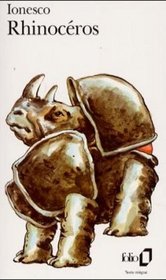Search -
Rhinocéros (French Edition)
Rhinocros - French Edition
Author:
Rhinocéros est la pièce la plus riche de Ionesco. Elle ne perd rien de l'esprit d'innovation, de provocation, des premières pièces. Comme elles, celle-ci mélange les genres et les tons, le comique et le tragique. Mais l'innovation principale qui s'introduit ici est la réflexion sur l'... more »
Author:
Rhinocéros est la pièce la plus riche de Ionesco. Elle ne perd rien de l'esprit d'innovation, de provocation, des premières pièces. Comme elles, celle-ci mélange les genres et les tons, le comique et le tragique. Mais l'innovation principale qui s'introduit ici est la réflexion sur l'... more »
ISBN-13: 9782070368167
ISBN-10: 2070368165
Publication Date: 11/1959
Pages: 246
Rating: 4
ISBN-10: 2070368165
Publication Date: 11/1959
Pages: 246
Rating: 4
3.5 stars, based on 4 ratings
Genres:
- Literature & Fiction >> Dramas & Plays >> Regional & Cultural >> European
- Literature & Fiction >> World Literature >> French
- Literature & Fiction >> Authors, A-Z >> ( I ) >> Ionesco, Eugene
- Literature & Fiction >> Foreign Language Fiction >> French





